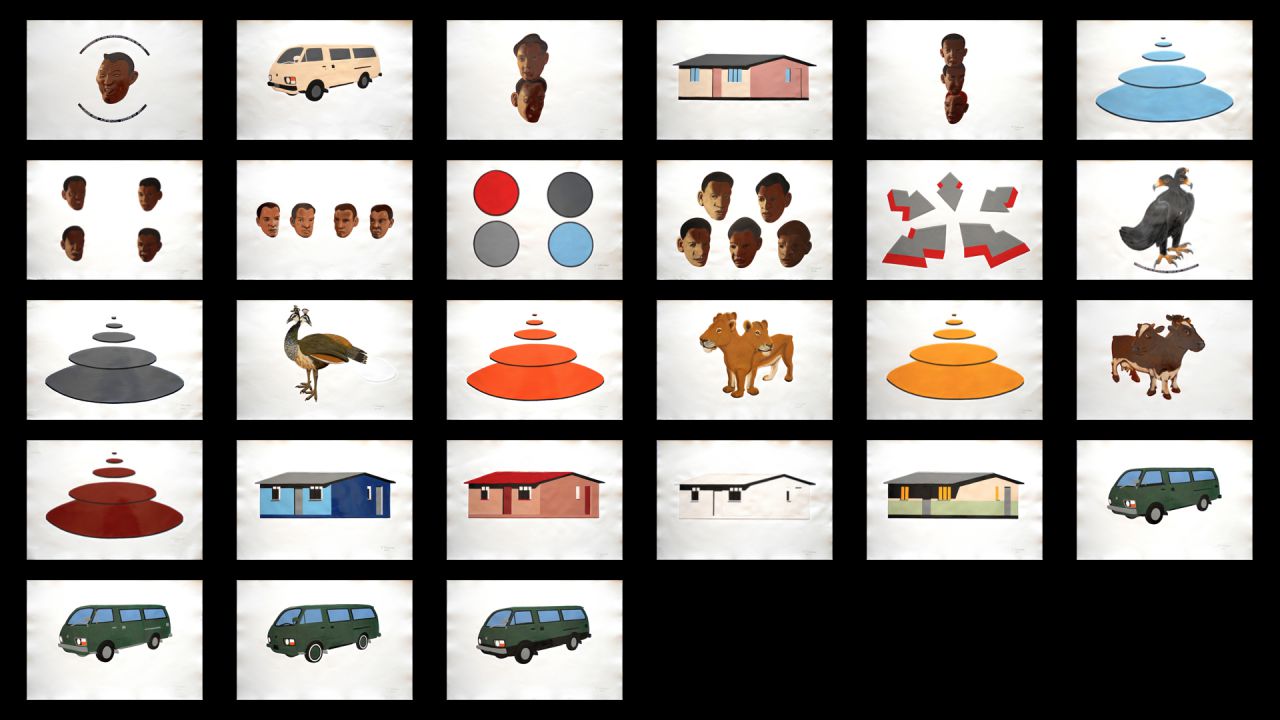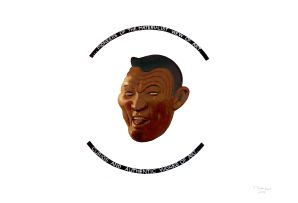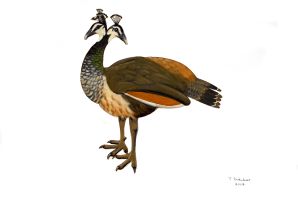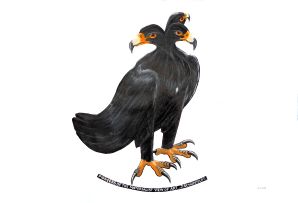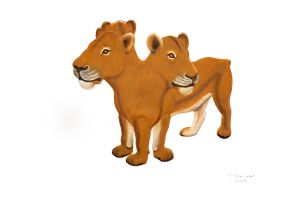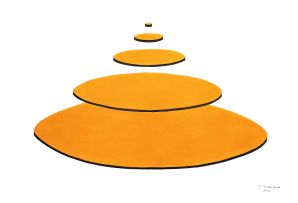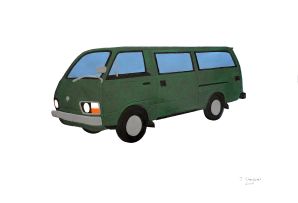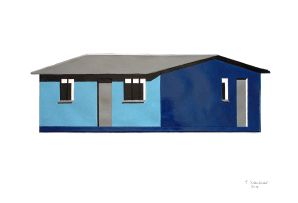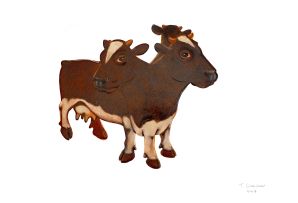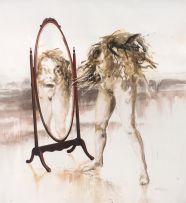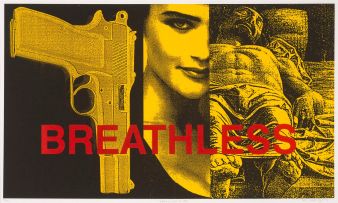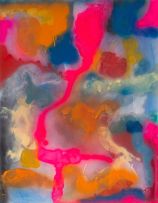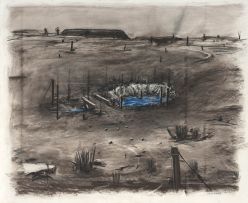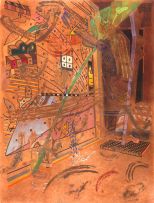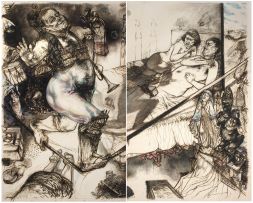The Model Men
Joachim Schönfeldt
About this Item
each signed and dated respectively in pencil in the margin
Notes
Writers sometimes commission illustrations to accompany their texts. In The Model Men, the process was reversed: the illustrations were made first and then a writer was commissioned to write about them. This was done not merely to challenge a convention. The Model Men explores a specific working methodology that seems to be prevalent at the moment, which may be stated simply as "how to animate dumb objects'' Where text is absent, the history of (African) oral societies is constructed from found and sourced objects, artefacts, implements, ruins and so on. We have seen anthropologists and palaeontologists work with "dumb objects'' and put a universe to them.
In my work I have tried to further the idea of objects as augmentation to speech, posing questions such as "In speech, when does a speaker revert to visuals?'' I have also looked at oral cultures, the charismatic speaker, and "priority perspectives'' - truth and what people want that truth to be. In the case of The Model Men, similar questions are explored in relation to illustrations as augmentation to written language.
The 26 illustrations are divided into two parts. The first set Silence!, is an organogram of portraits. Frans Hals and Rembrandt painted such portraits, depicting the board of a poorhouse, for instance Silence!, in my own thinking, is a sort of organogram of trustees or patrons, or the board of a hospital, asylum or sports club, or the committee of a taxi association, or the leaders of a political party, or perhaps just the members of a crime syndicate.
Five of the illustrations are portraits; the first shows one face, the second shows two faces, and so on. Each of the portraits has an additional illustration associated with it, which I refer to as a double. I paired the one-face portrait with a taxi (as an example of transport). The two-face portrait is paired with a typical matchbox township house (used here as an example of location). The double of the three-face portrait is a social pyramid
(a diagrammatic representation of social strata, with the king at the apex and the people at the base, and the tiers of the church, the military and the bourgeoisie in between). The double of the five-face portrait is four dots and the double of the five-face portrait a five-pointed castle. I refer to these doubles as narrative description. I tried, in my own mind, to prepare the illustrations in a way that would appeal to a writer; the doubles were designed to prompt or provoke narratives
The second set of illustrations, Roar, tries to imagine what the iconography of a pan-African religion might look like. There are four animals, all female: a lioness, a cow, an eagle, and a peahen. The land animals have three heads. Like the Silence! illustrations, they also have doubles. In this instance the doubles are all social pyramid diagrams in various colours.
I tried to restrict the illustrations to singular images. There is no notion of a continuous narrative, as in Masaccio, here. The first image was started in 1996, The work proceeded by trial and error, and in the end the pieces had to serve various functions. The fact that they are meant to interest a writer as opposed to an artist has already been mentioned. The illustrations are also ultimately exhibition material. To distinguish between the illustrations as they exist on a computer screen or in a book, and the illustrations as they appear on exhibition, the technique of embossing was used. The reproductions do little justice to
the highly glossy embossed images. The
rather cumbersome and lengthy process of high relief embossing allowed for a kind of reward system for those who bother to attend the show.
A set of 26 illustrations was handed over to the writer Ivan Vladislavic. As mentioned above, these illustrations represented found and sourced objects, artefacts, implements and ruins, and the writer was invited to play the role of historian, anthropologist or palaeontologist. I did not explain my intentions in producing the illustrations, merely the work process. He had to make sense of the illustrations on his own: my role as creator has come to an end. In much the same way that the makers and users of found and sourced artefacts and implements cannot make a miracle appearance to correct the narrative of the historian or anthropologist, I cannot make a "death-defying appearance'' in the context of this work.
What I had anticipated would be a lengthy text at most, turned out to be a book, The Exploded View by Ivan Vladislavic. The book was published independently, outside the scope of this exhibition. A manuscript of the book was used in the selection of texts for the exhibition. The role of Andries Walter Oliphant, an academic and public intellectual, was in keeping with my work with Ivan Vladislavic. Oliphant's job was to consider the illustrations and the book of fiction together, and decide subjectively which illustration had generated which portion of the text. The texts he selected are displayed together with the embossed illustrations of The Model Men. Vladislavic and Oliphant wrote about their experiences of this project in separate essays included in the catalogue accompanying the exhibition that was mounted at the Wits Art Galleries in 2004.
- Joachim Schönfeldt
Exhibited
Wits Art Galleries, Johannesburg, The Model Men, 24 August to 10 September 2004.
Literature
Ivan Vladislavic. (2004) The Model Men, Johannesburg: Goldfields Press.
